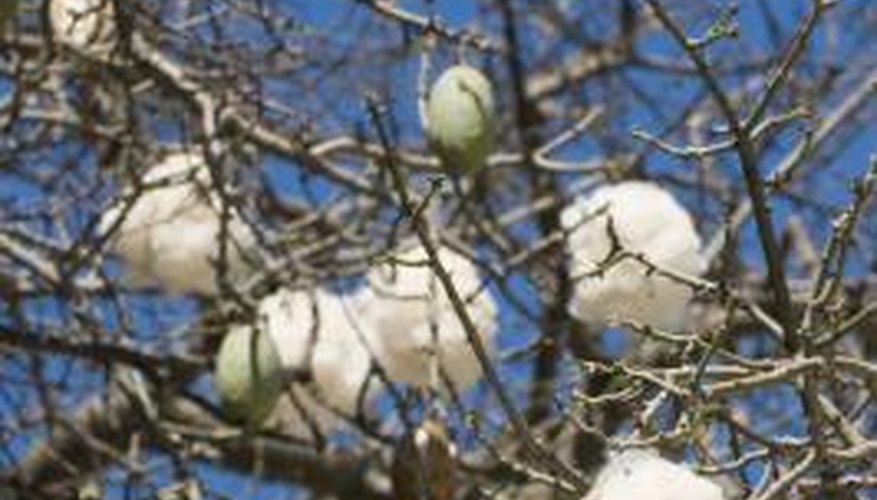Organic fibres have been used for many centuries to make cloth and are still used today. While some organic materials, such as wool, are taken from animals, a number of plants provide fibres that are spun into yarn and used to make cloth. Designers and manufacturers still make clothes from cloth incorporating fibres from plants such as cotton, flax and hemp.
Cotton
Cotton comes from plants that produce seed pods filled with ball-shaped clumps of cotton fibre. The seeds are separated from the cotton fibre mechanically. The process continues by spinning threads from the remaining, seedless white fibre. The threads are then woven to make cloth, which can be dyed. Cotton was grown in Pakistan's Indus Valley more than 5,000 years ago. Cotton was grown and used to make clothing in ancient Egypt. Cotton plants were exported to the Southern United States in the 17th century.
- Cotton comes from plants that produce seed pods filled with ball-shaped clumps of cotton fibre.
- Cotton was grown in Pakistan's Indus Valley more than 5,000 years ago.
Flax
Flax grows to a height of 4 feet and has leaves that consist of long, tough fibres. Flax has been used since ancient times to make clothing. The ancient Egyptians used flax to create linen cloth more than 4,000 years ago, and it was used in Medieval Europe to make cloth. Flax is still used to make fabrics for clothing, and it is commonly blended with synthetic materials and wool to add strength to fine yarns.
- Flax grows to a height of 4 feet and has leaves that consist of long, tough fibres.
- Flax is still used to make fabrics for clothing, and it is commonly blended with synthetic materials and wool to add strength to fine yarns.
Hemp
Hemp comes from the Cannabis sativa plant and has been used to make cloth since ancient times. In the 1980s, producers were able to make fine cloth suitable for clothing from hemp. This development occurred following the discovery of a process using enzymes that removed the fibres' roughness while still allowing the fibre to retain its durability. Designers currently use hemp, blended with other textiles, to make fine cloth, in contemporary designs. Hemp fibre is resistant to stretching, which allows clothes made from cloth woven with hemp fibres to retain their shape and size. Hemp typically grows in warm climates, such as those found in tropical regions.
- Hemp comes from the Cannabis sativa plant and has been used to make cloth since ancient times.
- Hemp fibre is resistant to stretching, which allows clothes made from cloth woven with hemp fibres to retain their shape and size.
Ramie
Ramie is grown in East Asia, and is known as China grass. Ramie fibres have been found in fabrics used to wrap mummies in ancient Egypt. Ramie fibres are fine and produce delicate silk-like threads when spun, although the fibres can become brittle when a dry process is used to spin them. Cloth made from Ramie is resistant to stain and has a slight sheen that reflects light. Ramie fabrics are also used in the manufacture of garments because the cloth does not readily shrink.
- Ramie is grown in East Asia, and is known as China grass.
- Ramie fabrics are also used in the manufacture of garments because the cloth does not readily shrink.
